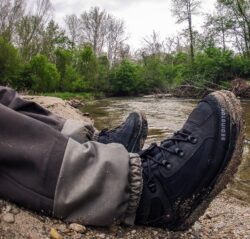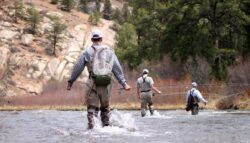Spring fishing means slick surfaces. The rocks and bank are often covered in ice and snow. As the waters warm up, algae and moss will make surfaces even slicker.
Falling on a river is never graceful or comfortable. Ankles can get twisted, limbs broken or sprained, bodies can become bruised and battered. Your gear can also get broken, torn, and ruined.
So how can anglers stay upright and avoid falling? Here are several suggestions.
Wading Staff There are boatloads of wading staffs available commercially. My favorite is a collapsible wading staff that fits into a holster on your belt. You can snap it out when needed and fold it when it gets in the way. You can also use old ski poles for safe wading. Attach a cord to the handle so that the staff will stay nearby when you drop it. In a pinch, cut a stick!
Fish Nets A fish net hooked onto your vest is also handy when keeping your balance. You can push it onto rocks and logs to add stability. If you place the net in a current and turn it sideways, the resistance will help keep you stable. A long-handled net can double as a walking staff.
Wading Shoes/ Boots Back in the day, carpet and wool soles were added to boots for traction. Due to invasive snails and algae, these are now outlawed in most states and National Parks. Instead, newer Vibram sole blends help add traction. Combined with metal studs, these moon boots can make a wader like a Tank!
Look for smoother waters An angler must know their limitations. If an area of the river looks too rough, avoid it, and find easier crossings. Gravel, shallows, and less current will make for an easier passage.
Link your arms If wading with a friend, link arms to help make a crossing. Put the biggest angler upstream and hang on. 4 feet is better than 2.
Head into the current Leaning and walking into the current is safer than heading downstream. Moving water will also move you. The friction of the water will serve as leverage to make a crossing. Avoid getting broadside or completely facing the current. Plant an upstream leg and then move the downstream one. This is also when the wading staff really helps.
Is it worth it? If the place you are trying to wade is too dangerous, find another spot. No one needs to die over a fish!
Cell phones and cameras These expensive electronics need to be in waterproof containers, in case you fall into the water. Keep your matches dry as well in case you need to build a fire.
WHOOPS!!! So, you are wading the river and falling, now what? The first thing you will feel is the shock from the cold water. Hopefully your chest waders have a belt to prevent water from entering your waist down boots. This means that they will be full of air and buoyant. Face downstream and use your legs to avoid obstacles. Go with the flow and angle towards the shore. Once in the shallows, you can stand up with help from your net, wading staff, or friend. Usually, we hang onto our rods and hold them high unless the water is over our heads. In that case let the rod go and swim for it. The rod will float due to its cork handle and can often be retrieved downstream. No gear is worth dying over.
If you are injured, allow yourself to float and gradually make your way to shallower water. Don’t panic!
If you get wet, get out of the wet gear, and dry off. Hypothermia is dangerous. Build a fire if possible or get back to the truck/camp. Once there, get off the wet stuff, towel off and dry off. If you need first aid, this is when you get the kit out or call for help.
Wading takes practice and skill. Until you are confident, use a wading staff!
Montana Grant
Join Montana Grant on Facebook at “Montana Fishing For Fun”.